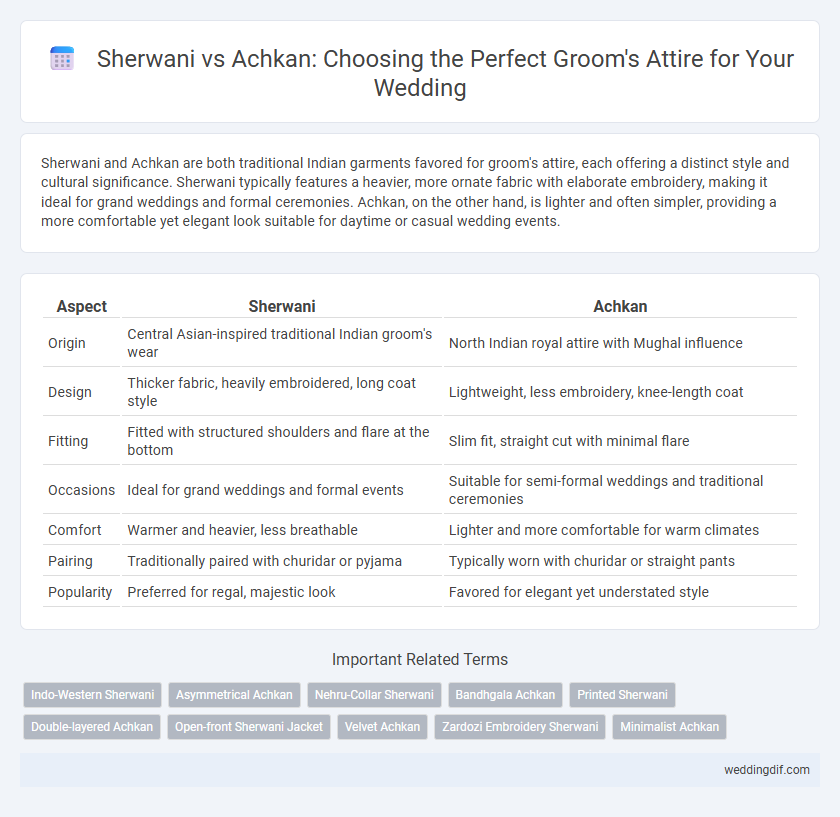Sherwani and Achkan are both traditional Indian garments favored for groom's attire, each offering a distinct style and cultural significance. Sherwani typically features a heavier, more ornate fabric with elaborate embroidery, making it ideal for grand weddings and formal ceremonies. Achkan, on the other hand, is lighter and often simpler, providing a more comfortable yet elegant look suitable for daytime or casual wedding events.
Table of Comparison
| Aspect | Sherwani | Achkan |
|---|---|---|
| Origin | Central Asian-inspired traditional Indian groom's wear | North Indian royal attire with Mughal influence |
| Design | Thicker fabric, heavily embroidered, long coat style | Lightweight, less embroidery, knee-length coat |
| Fitting | Fitted with structured shoulders and flare at the bottom | Slim fit, straight cut with minimal flare |
| Occasions | Ideal for grand weddings and formal events | Suitable for semi-formal weddings and traditional ceremonies |
| Comfort | Warmer and heavier, less breathable | Lighter and more comfortable for warm climates |
| Pairing | Traditionally paired with churidar or pyjama | Typically worn with churidar or straight pants |
| Popularity | Preferred for regal, majestic look | Favored for elegant yet understated style |
Introduction to Groom’s Traditional Attire
Sherwani and Achkan are quintessential choices for a groom's traditional attire, each reflecting rich cultural heritage and elegance. The Sherwani features a heavier, often heavily embroidered fabric with a more structured silhouette, ideal for grand weddings, while the Achkan offers a lighter, streamlined look typically paired with churidar pants. Both attires symbolize regal sophistication, making them timeless options for grooms seeking to honor tradition with style.
What is a Sherwani?
A Sherwani is a long, coat-like garment traditionally worn by grooms in South Asian weddings, characterized by its rich embroidery, structured fit, and luxurious fabric such as silk or brocade. It originates from the Mughal era and is designed to exude regal elegance, often paired with churidar or dhoti pants. Compared to an Achkan, a Sherwani typically features heavier embellishments and a more formal silhouette, making it a popular choice for grand wedding ceremonies.
What is an Achkan?
An Achkan is a traditional Indian groom's attire characterized by its embellished, knee-length coat with a close-fitting silhouette and often paired with churidar pants. Unlike the Sherwani, which is typically heavier and more ornate, the Achkan offers a lighter, more streamlined look suitable for formal wedding ceremonies. Its historical roots in royal Mughal fashion make it a sophisticated choice for grooms seeking elegance with cultural significance.
Historical Origins: Sherwani vs Achkan
The Sherwani originated during the Mughal era as a royal garment symbolizing power and prestige, characterized by its heavy embroidery and longer length. The Achkan, with roots in North Indian and Punjabi traditions, is a lighter, knee-length coat often paired with churidar, reflecting a more regional and festive style. Both attires hold cultural significance but differ in historical context, with the Sherwani linked to aristocratic Indo-Persian influences and the Achkan rooted in local Indian heritage.
Style and Design Differences
Sherwanis feature rich embroidery and heavier fabrics, showcasing a regal and traditional look ideal for grand weddings, while achkans are tailored with lighter materials and minimal embellishments, offering a more streamlined and contemporary silhouette. The sherwani typically has a longer length with intricate patterns, often paired with a churidar, whereas the achkan is shorter, resembling a fitted coat, usually worn with trousers for a polished appearance. Both styles emphasize elegance but cater to different aesthetic preferences, with sherwanis leaning towards opulence and achkans favoring subtle sophistication.
Suitable Occasions for Sherwani and Achkan
Sherwanis are ideal for grand weddings and formal receptions, offering an ornate and regal appearance with heavier embellishments and rich fabrics. Achkans are better suited for daytime events, less formal ceremonies, and cultural occasions, presenting a sleek, tailored look with lighter embroidery. Both attire choices reflect traditional Indian heritage but cater to different event tones and cultural settings.
Fabric and Embroidery Choices
Sherwanis typically feature heavier fabrics like silk brocade or velvet, adorned with intricate zari or zardozi embroidery, creating a regal and opulent look ideal for grand weddings. Achkans are often crafted from lighter fabrics such as raw silk or cotton blends, with delicate threadwork or subtle embroidery patterns emphasizing elegance and comfort. Both attire choices incorporate traditional craftsmanship, but Sherwanis lean towards elaborate embellishments, while Achkans balance intricate details with wearability for various wedding functions.
Comfort and Fit for Grooms
Sherwanis offer a structured fit with detailed embroidery, providing a regal look but may feel heavier and less breathable for long ceremonies. Achkans are typically lighter and more tailored towards a streamlined, comfortable fit, making them ideal for grooms prioritizing ease of movement. Choosing between Sherwani and Achkan depends on balancing traditional grandeur with personal comfort and fit preferences.
Modern Trends: Sherwani vs Achkan
Modern trends in groom's attire showcase a growing preference for sherwanis due to their richly embroidered fabrics and regal silhouette, offering a versatile blend of tradition and contemporary style. Achkans, with their tailored fit and simpler design, appeal to grooms seeking a subtle elegance and comfort, often favored in daytime or less formal weddings. Designers increasingly experiment with fusion elements, blending sherwani's grandeur with achkan's minimalism, reflecting evolving tastes in wedding fashion.
Choosing the Perfect Attire for Your Wedding
Sherwanis offer a rich, embroidered look ideal for traditional South Asian weddings, providing a regal and formal appearance with a luxurious fabric blend. Achkans provide a slightly more streamlined silhouette that combines elegance and comfort, often favored in semi-formal or modern wedding settings. Selecting between Sherwani and Achkan depends on the wedding theme, cultural significance, and personal style preferences to ensure the groom stands out on his special day.
Sherwani vs Achkan for groom's attire. Infographic

 weddingdif.com
weddingdif.com